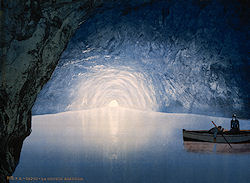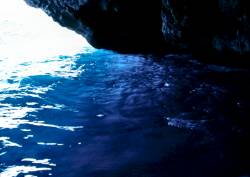Blue Grottos


There are many Blue Grottoes in the world, all of them are sea caves. Or more exact: caves partly filled with seawater with an entrance at or below sea level.
The reason for the name is always the same: the partly water-filled cave has a connection to the sea. Sunlight entering the cave through the water gives the cave a mystic blue shine as the water filters the light and lets only the blueish components into the cave. The light shows all shades from emerald green to turquoise blue.
Most blue grottos are entered by boat, sometimes you have to swim or dive to enter the cave. The Grotta Smeralda has a natural entrance deep below sea level, and is entered through an artificial entrance. And except for this one, which means Emerald Cave or Green Cave, they are all called Blue Grotto in the respective national language. This is probably due to the great fame of the Grotta Azzurra on Capri, which has achieved worldwide fame since the 19th century.
- Examples
 Grotta Azzurra, Capri, Italy. The original, world famous.
Grotta Azzurra, Capri, Italy. The original, world famous. Grotta dello Smeraldo, Capri, Italy. Green instead of blue, but more or less the same.
Grotta dello Smeraldo, Capri, Italy. Green instead of blue, but more or less the same. Il-Hnejja, Malta.
Il-Hnejja, Malta. Γαλαζια Σπιλια (Galázia Spiliá), Kastellórizo, Greece.
Γαλαζια Σπιλια (Galázia Spiliá), Kastellórizo, Greece. Γαλαζια Σπιλια (Galázia Spiliá), Skiathos, Greece.
Γαλαζια Σπιλια (Galázia Spiliá), Skiathos, Greece. Γαλαζια Σπιλια (Galázia Spiliá), Zakynthos, Greece.
Γαλαζια Σπιλια (Galázia Spiliá), Zakynthos, Greece. Modra Špilja, Biševo, Croatia.
Modra Špilja, Biševo, Croatia. Zelena Špilja, Biševo, Croatia.
Zelena Špilja, Biševo, Croatia. Plava pećina, Montenegro.
Plava pećina, Montenegro. Catedral de Marmol, Chile.
Catedral de Marmol, Chile.
- See also
 Search DuckDuckGo for "Blue Grotto"
Search DuckDuckGo for "Blue Grotto"

 Index
Index Topics
Topics Hierarchical
Hierarchical Countries
Countries Maps
Maps